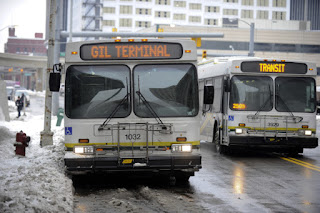Shayndi Raice and Laura Stevens report in the Wall Street Journal, photo by Bryan Mitchell in Bloomberg:
Amazon selected 20 finalists from 238 applicants. Some say they are learning from the disappointing phone conversations and making changes: restructuring workforce development programs to focus on tech talent; starting a community fund to invest in local tech companies and more entrepreneurs; pushing for a new regional transportation network that would connect outer counties to the city. (But) “They should build their own economies and not let any large company tell them what to do.”
Amazon Inc. has made about 200 phone calls to cities the retail giant rejected for its second headquarters. Some of the cities say they are learning from the disappointing phone conversations and making changes.
Cincinnati and Sacramento, Calif., are restructuring workforce development programs to focus on tech talent. Orlando, Fla., is considering starting a community fund to invest in local tech companies and draw more entrepreneurs. In Detroit, elected officials and business leaders are pushing a ballot initiative for a new regional transportation network that would connect outer counties to the city.
Amazon has selected 20 finalists from 238 applicants from metro areas and regions like Detroit and Baltimore to small towns in Texas for its $5 billion second corporate headquarters, which it has said could create up to 50,000 high-paying jobs. Demands in its request for proposals included a metro area with a population of more than one million, public transportation, a big airport with plenty of connections to Seattle and a large pool of tech talent.
In Detroit, assistant Wayne County executive Khalil Rahal got a call from Amazon’s Holly Sullivan, head of the HQ2 search, telling him Detroit wasn’t going to make the list of finalists.
Ms. Sullivan agreed to a conference call with other city leaders to further explain where it fell short. A key issue she raised was the lack of a regional transportation network, Mr. Rahal said. The city itself didn’t have enough tech workers to fill 50,000 jobs. Because of that, it was essential that the city had a way—besides cars—to bring in workers from outer counties. But Detroit’s public transportation system provides limited options for those outside the city.
Ms. Sullivan’s explanation didn’t come as a shock to Detroit. Wayne County tried in 2016 to push a similar transit plan, but the ballot was voted down by a slim margin. City leaders think they have a better shot now at passing a plan, since they have evidence that a lack of a regional transportation network is holding back development. A vote to place the initiative on a November ballot is currently planned for early June.
“Amazon was a wake-up call,” said Gerry Anderson, chief executive of DTE Energy Co., and one of 23 metro-Detroit business executives who wrote a letter pleading for a regional transportation plan, highlighting the Amazon loss in their pitch. “What becomes undeniable for people is that here’s an outsider that would have been a very attractive investor who looked at our transit system and did not like what they saw.”
States often offer large tax breaks and other financial incentives to woo firms to set up shop locally. Elected officials will tout wins as evidence they are creating jobs. But in most cases, the site selection process is negotiated quietly, between a company, their consultants and local government. The highly visible Amazon process is forcing cities to explain why they didn’t make the cut, and address those weaknesses.
“It is a kind of look-in-the-mirror moment,” said Joseph Parilla, of the Brookings Institution.
Richard Florida, a professor at the University of Toronto and critic of the Amazon HQ2 process, says it is misguided for cities to focus on Amazon’s criticisms.
I don’t think communities should be rushing to please Amazon,” he said. “They should be looking to build their own regional economies and not trying to let any large company tell them what to do.”
Not all cities received an in-depth critique from Amazon. In Sacramento’s postmortem call, Amazon officials were complimentary and didn’t go into too much detail, said Barry Broome, president and CEO of the Greater Sacramento Economic Council. The city may do a deeper dive with the team after the final site selection is made, Mr. Broome said, but it isn’t waiting for another call to make changes.
“Post-Amazon, we’re now restructuring all of our workforce programs in the area,” Mr. Broome said, to focus on providing more digital-skills training. The Sacramento Area Council of Governments, which works on regional transportation issues, is coming out with a recommendation on May 3 to improve its transit system. “It gave us a chance to be benchmarked nationally,” he said.
Johnna Reeder, chief executive of Cincinnati’s regional economic development initiative, said the city’s postmortem call with Amazon helped officials realize they needed to put their current plans “on steroids.”
The Cincinnati Regional Chamber refocused an apprentice program for public high-school students on information-technology firms, to address Amazon’s criticism that the city didn’t have enough homegrown tech talent, said Jordan Vogel, who runs talent programs for the chamber. It also added events for summer interns at businesses in the city that focus on information technology.
Following the Amazon loss, the chamber was able to secure funding for a website aimed at bringing tech talent to the region, said Mr. Vogel. Before that, the group couldn’t get enough interested donors, he said.
Missouri hired consulting firm PricewaterhouseCoopers Public Sector LLP to do an analysis of its current economic development structure and create a new strategy that allows the state to be more competitive. “If we’re going to compete for the next HQ2 project out there, we know we’re going to have to fundamentally rethink our economy, and that’s what this is all about,” said Rob Dixon, head of the Missouri Department of Economic Development.



















0 comments:
Post a Comment